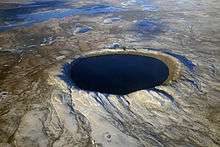Rubielos de la Cérida impact structure
The c. 80 km x 40 km sized Rubielos de la Cérida impact structure (impact basin, resp.) is located in Aragon, northeast Spain, north of Teruel and is considered[1][2][3][4][5][6] a companion of the Azuara impact structure and part of a large multiple impact event, the Azuara impact event, that from stratigraphic considerations and paleontological dating happened in the Upper Eocene or Oligocene (roughly 30 - 40 Mill. years ago). The name is attributed to the village of Rubielos de la Cérida located in the central uplift of the most northerly part of the structure.
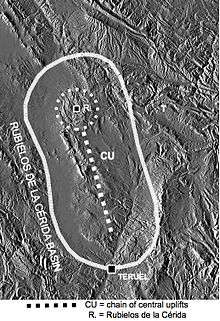
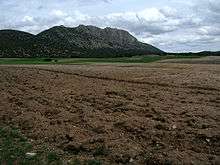
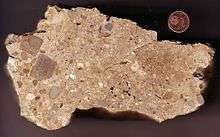
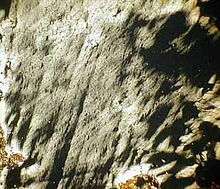
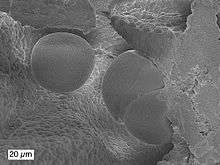
Originally the Rubielos de la Cérida structure was limited to and described as a 40 km-diameter circular impact crater with a prominent central uplift but is now considered to comprise a whole crater chain forming an impact basin accompanied by a central uplift chain.[7] In the eastern part, the morphology of the original basin is in parts buried beneath post-impact Neogene sediments.
Conventionally, the impact basin is considered to represent tectonic structures, the Jiloca-Calatayud graben and the Alfambra-Teruel graben. Since a tectonic graben is typically characterized by tensional features, the common interpretation meets basic difficulties with the structurally dominant compressive style that was observed.[4]
Impact features
The impact nature is documented by impact melt rocks, suevite, abundant polymictic and monomictic breccias, breccia dikes (dike breccias), extensive megabreccias, impact ejecta, dislocated megablocks, peculiar geological structures in the rim and central uplift zones, and shock metamorphism.[2][3][4][5] Shock effects comprise melt glass, diaplectic glass from quartz and feldspar, planar deformation features (PDFs) in quartz and feldspar and moderate shock effects like intense kink banding and multiple sets of planar fractures (PFs) in quartz, multiple sets of kink bands in mica, and intense micro-twinning in calcite. Moderately developed shatter cones[8] add to the impact signature.
Controversy
The origin of the Rubielos de la Cérida structure has been debated, and Spanish geologists still remain opposed to an impact origin.[9][10][11] In their opinion and with regard to the Spanish impact event, the shock effects are tectonic features, the impact ejecta are Cenozoic alluvial fans or conglomerates and supposed impact breccias and dike breccias are interpreted as karst features and soil formations.
The opposition against the impact origin for Rubielos de la Cérida (and Azuara) has been supported by an analysis and paper (Langenhorst & Deutsch 1996)[12] denying the occurrence of shock metamorphism in Azuara rocks.[13][14]
Despite the impact evidence for Rubielos de la Cérida underlined by the occurrence of strong shock metamorphism, the crater (like Azuara) is not listed in the Canadian Earth Impact Database. Rubielos de la Cérida is however listed as a confirmed impact structure in other data bases, e.g. Moilanen,J.[15] and the Expert Database on Earth Impact Structures (EDEIS).[16]
References
- Ernstson, K., Anguita, F., and Claudin, F. 1994. Shock cratering of conglomeratic quartzite pebbles and the search and identification of an Azuara (Spain) probable companion impact structure, in: Shock wave behavior of solids in nature and experiments, 3rd ESF-Impact Workshop Limoges, abstract book: 25..
- "SILICATE". www.granada-workshop.impact-structures.com. Hradil, K., Schüssler, U., and Ernstson, K. 2001. Silicate, phosphate and carbonate melts as indicators for an impact-related high-temperature influence on sedimentary rocks of the Rubielos de la Cérida structure, Spain, in: Impact markers in the stratigraphic record, 6th ESF-IMPACT workshop Granada, abstract book: 49-50.
- "STRIAE". www.granada-workshop.impact-structures.com. Claudin, F., Ernstson, K., Rampino, M.R., and Anguita, F. 2001. Striae, polish, imprints, rotated fractures, and related features from clasts in the Puerto Mínguez impact ejecta, in: Impact markers in the stratigraphic record, 6th ESF-IMPACT workshop Granada, abstract book: 15-16.
- (PDF) http://www.impact-structures.com/pdfall.pdf. Missing or empty
|title=(help) Ernstson, K., Claudin, F., Schüssler, U. & Hradil, K. (2002): The mid-Tertiary Azuara and Rubielos de la Cérida paired impact structures (Spain). - Treb. Mus. Geol. Barcelona, 11, 5 - 65. - "IMPACT MELT ROCKS". www.granada-workshop.impact-structures.com. Ernstson, K., Claudin, F., Schüssler, U., Anguita, F. and Ernstson, T. 2001. Impact melt rocks, shock metamorphism, and structural features in the Rubielos de la Cérida structure, Spain: evidence for a companion to the Azuara impact structure, in: Impact markers in the stratigraphic record, 6th ESF-IMPACT workshop Granada, abstract book: 23-24.
- Ernstson, K., Rampino, M. R., and Hiltl, M. 2001. Cratered cobbles in Triassic Buntsandstein conglomerates in northeastern Spain: An indicator of shock deformation in the vicinity of large impacts. Geology, 29: 11-14.
- , Ernstson, K., Schüssler, U., Claudin, F., and Ernstson, T. (2003). An impact crater chain in northern Spain. Meteorite, 9, no 3, 35-39.
- "http://www.impact-structures.com/shattercone/shatterconepage.html". External link in
|title=(help) - Cortés A. L., Diaz-Martínez E., Sanz-Rubio E., Martínez-Frías J. and Fernández C. (2002) "Cosmic impact versus terrestrial origin of the Azuara structure (Spain): A review." Meteoritics & Planetary Science 37: 875-894.
- Diaz Martínez, E., Sanz Rubio, E., and Martinez Frias, J (2002): Sedimentary record of impact events in Spain. Geological Society of America. Special Paper 356: 551-562.
- Díaz-Martínez, E. 2005. Registro geológico de eventos de impacto meteorítico en España: revisión del conocimiento actual y perspectivas de future. [Geological record of meteorite impact events in Spain: review of current knowledge and future perspectives.]. Journal of Iberian Geology 31 (1) 2005: 65-84.
- Langenhorst F. and Deutsch A. (1996) The Azuara and Rubielos structures, Spain: Twin impact craters or Alpine thrust systems? Lunar and Planetary Science XXVII.
- "http://www.impact-structures.com/spain/shock-metamorphism.html". External link in
|title=(help) Shock effects (shock metamorphism) in rocks. - "http://www.impact-structures.com/spain/controversy/controversy.htm". External link in
|title=(help) The controversy: The Spanish impact structures and competing models of an endogenetic origin. - "Impact Structures of the World". www.somerikko.net.; Moilanen J. (2009) List of impact structures of the World.
- http://tsun.sscc.ru/nh/impact.php?iname=&country=spain&min_age=0.0&max_age=3400.0&min_valid=0&max_valid=4&min_lat=-90&max_lat=90&min_lon=-180&max_lon=180&min_dia=0.0&max_dia=2250.0&search=Search+Database. Missing or empty
|title=(help) EDEIS Expert Database on Earth Impact Structures.
External links
| Wikimedia Commons has media related to Rubielos de la Cérida impact structure. |
- Comprehensive report on the Rubielos de la Cérida basin
- Comprehensive report on the Azuara structure
- Jarmo Moilanen's list of impact structures of the world
- The impact breccia page
- The suevite page
- Shatter cones
- EDEIS Expert Database on Earth Impact Structures
- Impact melt page - impact melt rocks
- Shock metamorphism page
- The Azuara - Rubielos de la Cérida controversy
- Understanding the Impact Cratering Process: a Simple Approach
